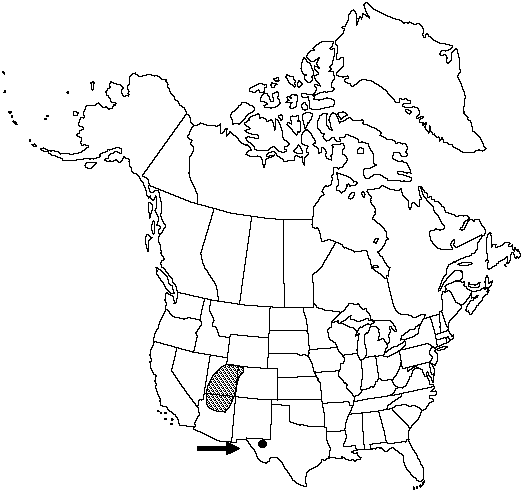Difference between revisions of "Cystopteris utahensis"
in Haufler & Windham, Amer. Fern J. 81: 13. 1991.
imported>Volume Importer |
imported>Volume Importer |
||
| Line 1: | Line 1: | ||
{{Treatment/ID | {{Treatment/ID | ||
|accepted_name=Cystopteris utahensis | |accepted_name=Cystopteris utahensis | ||
| − | |accepted_authority=Windham & Haufler | + | |accepted_authority=Windham & Haufler |
|publications={{Treatment/Publication | |publications={{Treatment/Publication | ||
| − | |title=in Haufler & Windham,Amer. Fern J. | + | |title=in Haufler & Windham, Amer. Fern J. |
|place=81: 13. 1991 | |place=81: 13. 1991 | ||
|year=1991 | |year=1991 | ||
| Line 32: | Line 32: | ||
-->{{#Taxon: | -->{{#Taxon: | ||
name=Cystopteris utahensis | name=Cystopteris utahensis | ||
| − | |authority=Windham & Haufler | + | |authority=Windham & Haufler |
|rank=species | |rank=species | ||
|parent rank=genus | |parent rank=genus | ||
| Line 43: | Line 43: | ||
|distribution=Ariz.;Colo.;Tex.;Utah. | |distribution=Ariz.;Colo.;Tex.;Utah. | ||
|reference=None | |reference=None | ||
| − | |publication title=in Haufler & Windham,Amer. Fern J. | + | |publication title=in Haufler & Windham, Amer. Fern J. |
|publication year=1991 | |publication year=1991 | ||
|special status= | |special status= | ||
| − | |source xml=https:// | + | |source xml=https://bitbucket.org/aafc-mbb/fna-data-curation/src/2e0870ddd59836b60bcf96646a41e87ea5a5943a/coarse_grained_fna_xml/V2/V2_501.xml |
|genus=Cystopteris | |genus=Cystopteris | ||
|species=Cystopteris utahensis | |species=Cystopteris utahensis | ||
Latest revision as of 20:23, 5 November 2020
Stems creeping, not cordlike, internodes short, heavily beset with old petiole bases, hairs absent; scales lanceolate, ± clathrate, radial walls dark brown, thick, luminae clear. Leaves monomorphic, clustered at stem apex, to 45 cm, nearly all bearing sori. Petiole green to straw-colored throughout or darker near base, shorter than blade, base sparsely scaly. Blade deltate to narrowly deltate, 2-pinnate-pinnatifid, usually widest at or near base, apex short-attenuate; rachis and costae with unicellular, gland-tipped hairs, misshapen bulblets present or absent; axils of pinnae usually with multicellular, gland-tipped hairs. Pinnae typically perpendicular to rachis, not curving toward blade apex, margins serrate; proximal pinnae pinnatifid to pinnate-pinnatifid, ± equilateral, basiscopic pinnules not enlarged; basal basiscopic pinnules sessile or short-stalked, base truncate to obtuse, distal pinnae ovate to oblong. Veins directed into teeth and notches. Indusia cup-shaped, apex truncate, with scattered, unicellular, gland-tipped hairs. Spores spiny, usually 39–48 µm. 2n = 168.
Phenology: Sporulating summer–fall.
Habitat: Cracks and ledges on cliffs, on calcareous substrates including sandstone, limestone, and dacite
Elevation: 1300–2700 m
Distribution

Ariz., Colo., Tex., Utah.
Discussion
Cystopteris utahensis is an allopolyploid derived from the diploid species C. bulbifera and C. reevesiana (C. H. Haufler and M. D. Windham 1991). Because C. utahensis shares one parent (C. bulbifera) with C. tennesseensis and because of morphologic similarities between C. reevesiana and C. protrusa (the second diploid parent of C. tennesseensis), populations of C. utahensis were previously considered to have originated by long-distance dispersal from eastern populations of C. tennesseensis. Genetic studies using isozyme markers, however, indicated that C. utahensis was a distinct species and stimulated the discovery of morphologic criteria for distinguishing it from its eastern cousin. When combined with the geographic separation of the two tetraploids, the minor differences in indument features provide a means of circumscribing this genetically distinct species. Potential confusion in identifying C. utahensis arises because sterile triploid hybrids may form when it is sympatric with the more common diploid C. reevesiana.
Selected References
None.